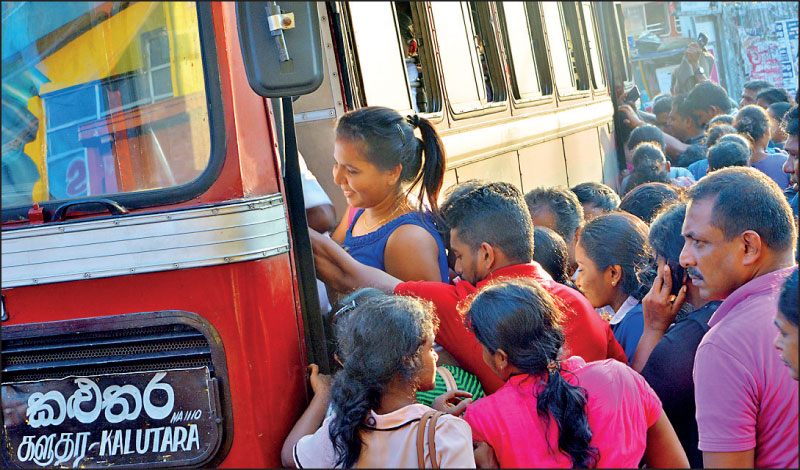Tuesday Mar 04, 2025
Tuesday Mar 04, 2025
Friday, 20 May 2022 00:35 - - {{hitsCtrl.values.hits}}

Anxieties about transport deter many from working and are steeped in reality – Pic by Shehan Gunasekara
 Sri Lanka’s gender gap in labour force participation is bad for the economy and for equality. It is also surprising, since Sri Lankan women are relatively healthy, educated and legally empowered. Sri Lankan women do well on health indicators such as life expectancy, fertility and infant mortality — measures normally associated with high female labour force participation (FLFP). They graduate in higher numbers from universities and schools than men. And they received the right to participate in elections as early as 1931. So why is Sri Lanka’s FLFP still lagging behind countries like Nepal, China, Myanmar and Bangladesh? And why did it drop by over 10% in the last three decades?
Sri Lanka’s gender gap in labour force participation is bad for the economy and for equality. It is also surprising, since Sri Lankan women are relatively healthy, educated and legally empowered. Sri Lankan women do well on health indicators such as life expectancy, fertility and infant mortality — measures normally associated with high female labour force participation (FLFP). They graduate in higher numbers from universities and schools than men. And they received the right to participate in elections as early as 1931. So why is Sri Lanka’s FLFP still lagging behind countries like Nepal, China, Myanmar and Bangladesh? And why did it drop by over 10% in the last three decades?
Part of this riddle is explained by Sri Lanka’s transition out of the agricultural sector — a major employer of women (at least 40% of agricultural workers globally are women). As the share of workers in agriculture halved between 1990 and 2017, Sri Lanka’s FLFP dropped by around 12%. When countries shift out of agriculture, jobs with higher wages often become available in the service and manufacturing sectors. At least one person in the household, usually male, secures a higher-wage job. And as households have more income, women — no longer forced to work due to financial hardship — start to have and exercise the choice not to work.
But that still doesn’t answer the question entirely. As the opportunity cost of staying at home increases, women usually start to re-enter the labour force. Over time, there are fewer children to care for, better social services, and more high-wage jobs. But in Sri Lanka, the downward trend in FLFP hasn’t yet reversed. To know why, we must explore what barriers continue to constrain female employment.
What society expects
Social norms governing child-care, elderly-care, and housework — designated “women’s jobs” — are the largest barriers to FLFP in Sri Lanka. The norms are enforced in a variety of ways including, in some areas, through abuse. Charles Mary Judith, 53, a mother of three from Anthoniyar Puram in Mannar District, says that some fisherwomen in her village who attempt to work are beaten by their husbands. Others are accused of sexual infidelity or promiscuity by their neighbours — even if they work with their husband’s consent.
Since the end of the civil war, gender roles have only become more entrenched. Over 40% of women of “marriageable” or “child-bearing” age cite “personal family responsibilities” as the main reason they aren’t employed. “I got used to looking after the children, the parents, the home,” says Farida Jeevnujee, 57, from Colombo, who stopped working after marriage. “Following our family tradition, women were largely expected to stay at home and take care of the kids.”
Being a mother — especially to a child younger than five years of age — is most strongly associated with remaining outside the labour force. In western Sri Lanka, the average mother spends five to seven hours a day on childcare. Najla Yehiya, a working mother of triplets, admits that without domestic workers, a supportive family and flexible work hours, employment “would be impossible”. Women who can employ domestic workers or enlist elderly family members to assist with children are much more likely to go to work. But many, Yehiya correctly observes, are not so lucky.
Discrimination in hiring, promotion and pay
Gender discrimination in hiring is another significant barrier to FLFP. Shanika De Alwis*, a 32-year-old architect, says she knows of at least two established architectural firms that don’t hire women. In sectors as diverse as research, IT, accounting and law there is an expectation that women cannot work late or perform as well as men.
And even if women are hired, they may still face discrimination. Highly-qualified female professionals are often expected to write minutes or make tea when at meetings. Unsurprisingly, in 2018, less than 10% of board directors in Colombo Stock Exchange-listed companies were women. There’s also evidence of glass ceilings in the public sector, where “men… are three times as likely to climb to the top as women.”
Alongside hiring and promotion discrimination is a gender wage gap. Sri Lankan women earn only 63% of what men do. Ruwantha Hettiarachchi*, a 39-year-old male manager, said, “I love employing women. They are more responsible and harder working than men but are generally satisfied with lower salaries.”
Sexual harassment
Workplace harassment and sexism can also push women to quit. The persistent undertone of sexism — which may occur in the form of jokes, unsolicited flirting or uninvited commentary about a woman’s personal life — can create toxic work environments. Sometimes the sexism is more explicit. Shanika* (32), an architect, left her last job because her employer was “a pervert”. “The straw that broke the camel’s back was when he hit my bottom with a plank lying in the office in front of all my colleagues,” she told me. While Shanika was able to find a better workplace, Sasi Manaleswamy, 42, who was also harassed at her last workplace, chose to quit working altogether.
Women face challenges even before they get to the workplace. Nojitha Sukumaran, 21, a kitchen assistant in Jaffna, says her mother didn’t want her to travel to work alone. Anxieties about transport deter many from working and are steeped in reality: 90% of Sri Lankan women endure harassment on public transport. In a bid to discourage her from working, “my mother didn’t talk to me for a month,” said Nojitha. The lack of safe, affordable, and accessible transport accounts for over 15% of the gap in FLFP.
Educational and occupational streaming
Educational streaming also constrains FLFP. Women start streaming into the arts and humanities at A-Levels and then opt into university courses that aren’t very employable. For example, although arts graduates are considered less employable, 80% are women. And while IT and engineering graduates find jobs easily, few are women. Ashmini J. Udhyani, 26, a recent graduate from the South-Eastern University, says that in her batch of 96 engineering students, only 21 were women. “Society believes that engineering is not for women. I’ve had to demonstrate to my parents over time that I could overcome any challenges.”
Male-dominated workplaces can then further discourage female employment. Managers may not think about separate restrooms or quarters for women, for example, and harassment can become entrenched in workplace culture. Once a critical mass of women is employed, however, more are encouraged to join. Sasi, for example, says she might consider working in a garment factory since she can then travel with and be surrounded by other women.
Occupational segregation is particularly concerning in light of the changing nature of work. Much work to be displaced in the future is currently performed by women, while women are also globally underrepresented in new and emerging fields. In Sri Lanka too, many male-dominated industries — logistics, engineering, ICT and hospitality — are high-growth. There is thus a continued risk that as such industries grow, women will increasingly be shut out of the workplace.
Legal, financial and administrative barriers
Female migrant workers are an important example of the diverse legal, financial and administrative hurdles constraining women’s work. In 1996, 75% of Sri Lanka’s migrant workers were women. But in 2019, less than 40% of overseas migrants were women. This reduction can be partly attributed to government policy. An example is the family background report, a requirement that actively discourages female migrant work.
Sri Lanka’s regulatory framework fails other women, too. Women with household and childcare obligations would benefit from flexible work arrangements. But since termination packages for part-time and full-time workers cost the same, employers may avoid hiring part-time workers. Additionally, since the state doesn’t bear the costs of maternity leave, private-sector employers may think twice about hiring women of “childbearing” age. And that’s not all — women are also subjected to discriminatory night-time and overtime restrictions, making them “undesirable” in some industries.
The riddle of low female labour force participation in Sri Lanka can be explained via barriers to women’s work. Women are harassed on their way to and while at work. They face discrimination in hiring, promotion and pay. Poorly-designed and discriminatory regulations rob women of employment opportunities. And a woman’s expected roles as mother, wife and homemaker are limiting. In some cases, women even endure abuse before they are ‘permitted’ to work. To improve access to work, Sri Lanka must address these barriers. As Sri Lanka grapples with a crippling economic crisis, there’s no better time to do so than now.
*Names changed on request

Part 1 of this was published on 6 May 2022 and is accessible online via https://www.ft.lk/columns/Sri-Lanka-needs-more-women-in-the-workforce/4-734428
(The writer is an independent researcher and policy analyst.)
Discover Kapruka, the leading online shopping platform in Sri Lanka, where you can conveniently send Gifts and Flowers to your loved ones for any event including Valentine ’s Day. Explore a wide range of popular Shopping Categories on Kapruka, including Toys, Groceries, Electronics, Birthday Cakes, Fruits, Chocolates, Flower Bouquets, Clothing, Watches, Lingerie, Gift Sets and Jewellery. Also if you’re interested in selling with Kapruka, Partner Central by Kapruka is the best solution to start with. Moreover, through Kapruka Global Shop, you can also enjoy the convenience of purchasing products from renowned platforms like Amazon and eBay and have them delivered to Sri Lanka.
Discover Kapruka, the leading online shopping platform in Sri Lanka, where you can conveniently send Gifts and Flowers to your loved ones for any event including Valentine ’s Day. Explore a wide range of popular Shopping Categories on Kapruka, including Toys, Groceries, Electronics, Birthday Cakes, Fruits, Chocolates, Flower Bouquets, Clothing, Watches, Lingerie, Gift Sets and Jewellery. Also if you’re interested in selling with Kapruka, Partner Central by Kapruka is the best solution to start with. Moreover, through Kapruka Global Shop, you can also enjoy the convenience of purchasing products from renowned platforms like Amazon and eBay and have them delivered to Sri Lanka.